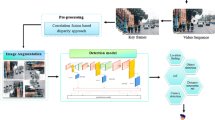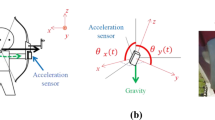Abstract
In this paper, a computer vision-based technique is proposed to track the motion trajectories of athletes to improve sport performance and deliver reliable physical data analysis. The moving target in the video was obtained through the Universal Background Eliminator (ViBe) moving target detection algorithm, and fused with the associated depth information based on the Kernerlized Correlation Filter (KCF) tracking algorithm. In order to better identify partly occluded objects, the depth information of the moving target and background segmentation threshold were acquired based on the depth distribution features within the original video tracking range. Meanwhile, the number of negative samples in the training sample set was reduced to prevent the model shifting problem caused by the background and obstacles. Experiments have been conducted on the dance trajectories of gymnasts as well as the motion trajectories of batting arms of badminton players. The results prove that the proposed algorithm can reduce the trajectory prediction error and improve the operating efficiency.







Similar content being viewed by others
Data availability
All data are available from the corresponding author.
References
Barnich O, Van Droogenbroeck M (2009) ViBe: a powerful random technique to estimate the background in video sequences. Proceedings of IEEE international conference on a Coustics, Speech Signal Processing, 945–948
Cheng S, Liu J, Li Z, Zhang P, Chen J, Yang H (2023) 3D error calibration of spatial spots based on dual position-sensitive detectors. Appl Opt 62(4):933–943. https://doi.org/10.1364/AO.479307
Comanciu D, Visvanathan R, Meer P (2003) Kernel-based object tracking. IEEE Trans on Pattern Analy Mach Intel 40(5):564–575
Hare S, Saffari A, Torr PHS (2011) Struck: structured output tracking with kernels. 2011 IEEE International Conference on Computer Vision (ICCV), 263–270
Henriques JF, Caseiro R, Martins P, Batista J (2015) High-speed tracking with Kernelized correlation filters. IEEE Trans Pattern Anal Machine Intel 37(3):583–596
Jiang WT, Liu WJ, Yuan H (2016) Research of object tracking based soft feature theory. Chin J Comput 39(7):1334–1355
Kalal Z, Mikolajczyk K, Matas J (2012) Tracking-learning-detection. IEEE Trans Pattern Anal Machine Intel 34(7):1409–1422
Li ZH, Shi Y (2018) Badminton smash arm image tracking trajectory correction simulation. Comput Simul 42(1):69–74
Li SE, Li G, Yu J, Liu C, Cheng B, Wang J, Li K (2018a) Kalman filter-based tracking of moving objects using linear ultrasonic sensor array for road vehicles. Mech Syst Signal Process 98(1):173–189
Li ZB, Tao Q, Kang JS (2018b) Evaluation of human upper limb motion comfort based on motion capture technique. Chinese J Engin Design 25(3):338–345 359
Liu L, Zhang S, Zhang L, Pan G, Yu J (2022) Multi-UUV maneuvering counter-game for dynamic target scenario based on fractional-order recurrent neural network. IEEE Trans Cybern:1–14. https://doi.org/10.1109/TCYB.2022.3225106
Lu S, Liu S, Hou P, Yang B, Liu M, Yin L, Zheng W (2023) Soft tissue feature tracking based on deep matching network. Comput Model Eng Sci 136(1):363–379. https://doi.org/10.32604/cmes.2023.025217
Martins P, Caseiro R, Henriques JF et al (2012) Discriminative Bayesian Active Shape Models. European Conference on Computer Vision. Springer, Berlin, Heidelberg
Meng Q, Lai X, Yan Z, Su C, Wu M (2021) Motion planning and adaptive neural tracking control of an uncertain two-link rigid-flexible manipulator with vibration amplitude constraint. IEEE Trans Neural Netw Learn Syst:1–15. https://doi.org/10.1109/TNNLS.2021.3054611
Meng X, Li Z, Wang S, Karambakhsh A, Sheng B, Yang P, Li P, Mao L (2020) A video information driven football recommendation system. Comput Electr Eng 85:106699
Min C, Pan Y, Dai W, Kawsar I, Li Z, Wang G (2023) Trajectory optimization of an electric vehicle with minimum energy consumption using inverse dynamics model and servo constraints. Mech Mach Theory 181:105185. https://doi.org/10.1016/j.mechmachtheory.2022.105185
Ning J, Zhang L, Zhang D (2012) Robust mean-shift tracking with corrected background-weighted histogram. IET Comput Vis 17(1):62–69
Sokhandan A, Monadjemi A (2018) Visual tracking in video sequences based on biologically inspired mechanisms. Computer Vision and Image Understanding
Talha M, Stolkin R (2014) Particle filter tracking of camouflaged targets by adaptive fusion of thermal and visible spectra camera data. Sensors J, IEEE 14(1):159–166
Wang F, Wang H, Zhou X, Fu R (2022) A driving fatigue feature detection method based on multifractal theory. IEEE Sens J 22(19):19046–19059. https://doi.org/10.1109/JSEN.2022.3201015
Wang S, Sheng H, Yang D, Zhang Y, Wu Y, Wang S. (2022) Extendable multiple nodes recurrent tracking framework with RTU++. IEEE Trans Image Process. https://doi.org/10.1109/TIP.2022.3192706
Wu Y, Lim J, Yang MH (2013) Online object tracking: a benchmark. Proceedings of 2013 IEEE Wu Y, Lim J, Yang M H. Online object tracking: a benchmark// Proceedings of 2013 IEEE Conference on Computer Vision and Pattern Recognition (CVPR)
Xu S, He Q, Tao S, Chen H, Chai Y, Zheng W (2022) Pig face recognition based on trapezoid normalized pixel difference feature and trimmed mean attention mechanism. IEEE Trans Instrum Meas 1. https://doi.org/10.1109/TIM.2022.3232093
Yan L, Shi Y, Wei M, Wu Y (2023) Multi-feature fusing local directional ternary pattern for facial expressions signal recognition based on video communication system. Alex Eng J 63:307–320. https://doi.org/10.1016/j.aej.2022.08.003
Yang PS, Wu XJ, Zhang YM (2016) Target tracking method based on improved Kalman filter algorithm. Comput Engin Appl 52(5):71–74,118
Yu NG, Wang J (2016) Non-contact gesture recognition method based on the information of the human arm joint. J Beijing Univ Technol 42(3):361–368
Yu Y, Cao MW, Yue F (2014) EVibe: an improved Vibe algorithm for detecting moving objects. Chin J Sci Instrum 35(4):924–931
Zhang B, Ebeid SM, Prevost R et al (2014) Fast solver for some computational imaging problems: a regularized weighted least-squares approach. Digital Sig Proc 27(1):107–118
Zong C, Wang H, Wan Z (2022) An improved 3D point cloud instance segmentation method for overhead catenary height detection. Comput Electr Eng 98:1. https://doi.org/10.1016/j.compeleceng.2022.107685
Funding
Not applicable.
Author information
Authors and Affiliations
Corresponding author
Ethics declarations
Conflict of interest
The authors declare that they have no known competing financial interests or personal relationships that could have appeared to influence the work reported in this paper.
Additional information
Publisher’s note
Springer Nature remains neutral with regard to jurisdictional claims in published maps and institutional affiliations.
Rights and permissions
Springer Nature or its licensor (e.g. a society or other partner) holds exclusive rights to this article under a publishing agreement with the author(s) or other rightsholder(s); author self-archiving of the accepted manuscript version of this article is solely governed by the terms of such publishing agreement and applicable law.
About this article
Cite this article
Zhang, L., Dai, H. Motion trajectory tracking of athletes with improved depth information-based KCF tracking method. Multimed Tools Appl 82, 26481–26493 (2023). https://doi.org/10.1007/s11042-023-14929-6
Received:
Revised:
Accepted:
Published:
Issue Date:
DOI: https://doi.org/10.1007/s11042-023-14929-6




